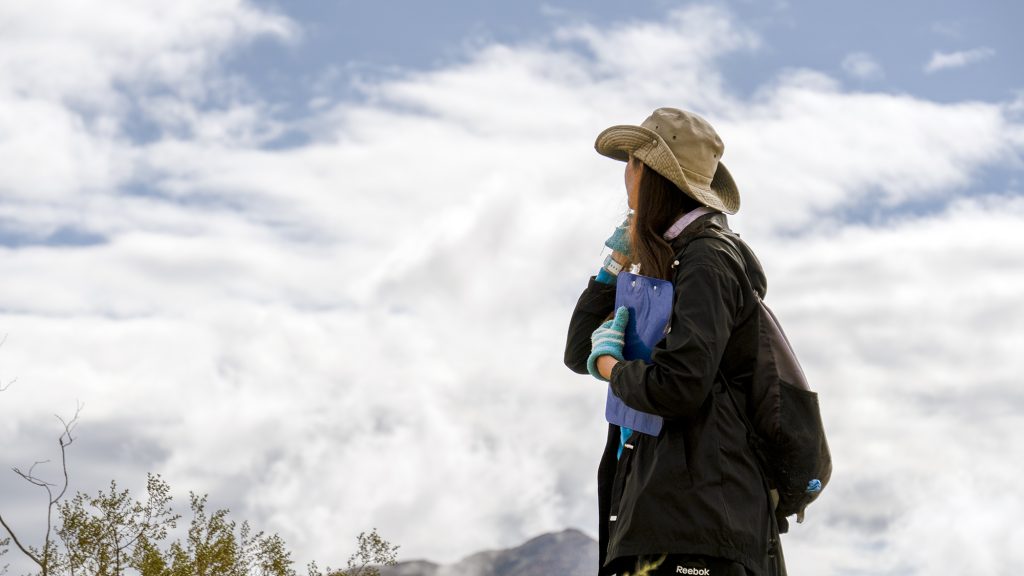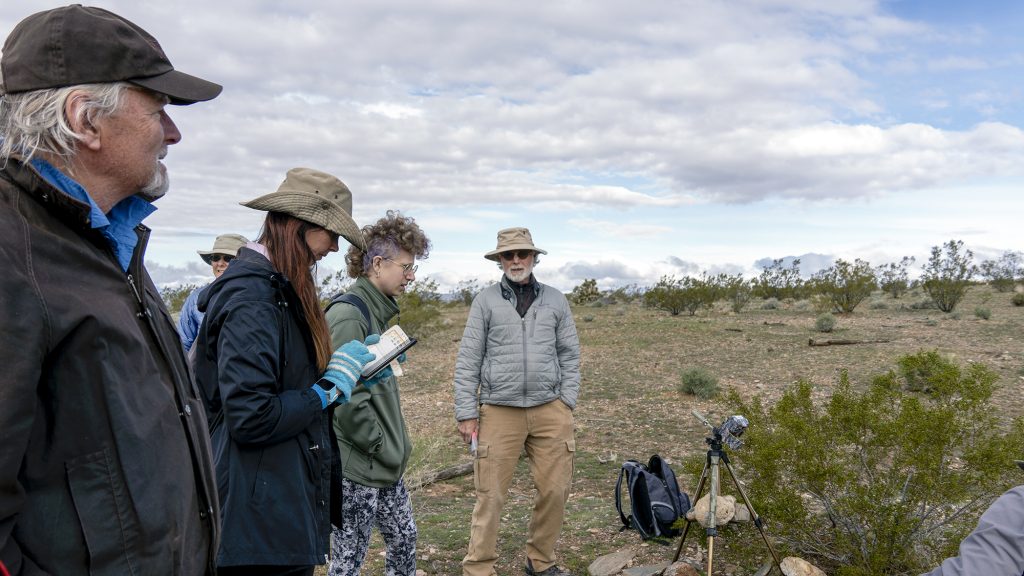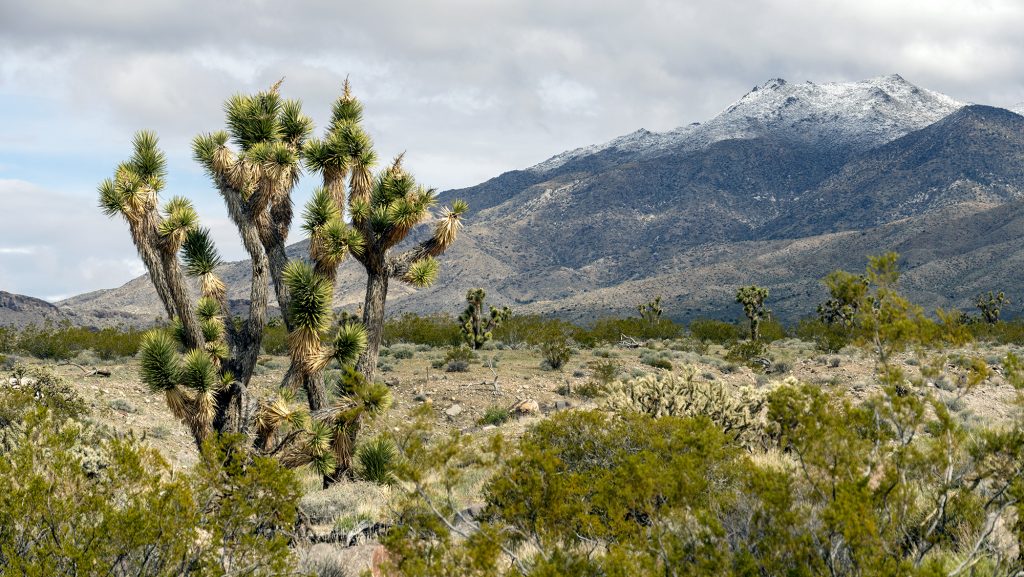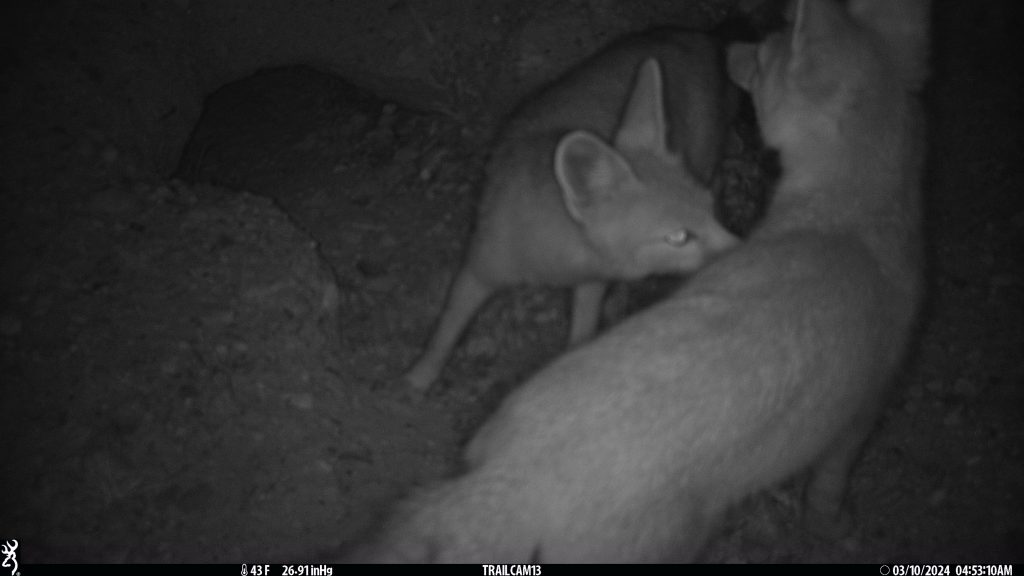ST. GEORGE — Jennifer Stone and Fred Armstrong lean on the ground to peer into what could be a Mojave desert tortoise burrow. On the other side of a large wash, Debi Turner and Ash Sargent navigate rocky, sandy terrain to scout for any sign of the reptiles.

These four comprised one of two volunteer groups from the nonprofit Conserve Southwest Utah in the area that Saturday morning, March 16.
Walking along the edge of washes and on “soil benches,” the narrow strips of land between steeper slopes, each group photographed and recorded potential signs of Mojave desert tortoises, such as scat, burrows or the reptiles themselves.
“I have a heartfelt thanks for the volunteers that have been involved with our program,” said Fred Armstrong, stewardship coordinator for Conserve Southwest Utah.
Once promising tortoise burrows are identified, the group can place remote monitoring cameras to determine whether they’re actively being used, he said.

John Kellam, Bureau of Land Management wildlife biologist for the Red Cliffs and Beaver Dam Wash national conservation areas, said the nonprofit is in year two of the project, which was funded, designed and coordinated by the local BLM office.
The BLM and nonprofit forged a Cooperative Assistance Agreement, which Kellam said would “bolster population monitoring that would inform management efforts for federally listed Threatened and Endangered and BLM Sensitive species within the Beaver Dam Wash National Conservation Area.”
“Areas within the NCA were identified as having limited or no current information on the Mojave desert tortoise and other BLM Sensitive species that could be affected by increasing visitor numbers, unauthorized dispersed camping, off-highway vehicle (OHV) use, and escalating risks of human-caused wildfires,” he said via email.
To address a gap in current data, the bureau enlisted the assistance of Armstrong, who is a retired biologist, to oversee and execute the project’s volunteer efforts, Kellam said.

“Because of the amount of habitat that’s being lost due to urbanization and increase of road use, they (Mojave desert tortoises) actually are on an extinction trajectory because reproduction success is slowly going down, down, down,” Armstrong said. “But thank goodness we have got some levelheaded, conservation-minded people in our local Bureau of Land Management Office who are concerned about public lands and sensitive species.”
Kellam said the work is focused on a 200-acre study area where no other field studies have been conducted.
Additionally, the area is near the Woodbury Desert Study Area, well-known to desert tortoise enthusiasts as the location of the groundbreaking study conducted by National Park Service biologist Angus Woodbury beginning in the 1930s, Armstrong said.

“He was one of the first full-fledged biologists who took an interest in these curious reptiles,” he said, adding that the plot once had one of the highest densities of desert tortoises in the Mojave Desert region. However, after World War II, Chevrolet began encouraging Americans to explore the U.S. and motor across the country.
“As we drive out to our study site, we’re going to pass by a feature — it’s called Castle Cliff and there used to be a gas station at that location,” he said. “And what they would do to encourage these travelers to stop at their souvenir store and gas station, as opposed to another one, is with every fill-up, you got a free desert tortoise. Little did they know that those long-term impacts on the tortoise population could contribute to the beginning of the end.”
Armstrong explained why they’re studying the area’s tortoises now.

“There has really not been an in-depth, systematic study of the wildlife of this localized area for about 20 years,” he said. “That is why it is important that CSU can provide the BLM this data as a snapshot in time. They will use our data to make informed land management decisions to benefit the multiple uses of this area.”
One of Conserve Southwest Utah’s primary goals is to “try and live and grow and act harmoniously with our landscape,” Armstrong said, adding that tortoises “are here for a purpose.” For instance, the burrows they dig can provide homes for other animals, like kit foxes, and allow water to flow underground to recharge aquifers.
“What happens if they’re no longer there? Then what happens to all those organisms that depend on them? That’s why it’s important for us to keep our finger on the pulse,” he said.

Conserve Southwest Utah conducted tortoise surveys and burrow monitoring using 24 wildlife cameras set out at 36 locations last summer and fall. Armstrong said at least 10 individual tortoises were identified as living on the landscape at various camera locations last year.
“We’re grateful to (the BLM) for their funding,” he added. “Because without it — well, we could do it on a volunteer basis, but it’s kind of tough to purchase supplies and cameras — things like that. … They are the main reason why we are out here doing this.”
Tortoises aren’t the only critters the group caught on camera.
Before the group conducted their survey, they observed a camera set up near a burrow to train new volunteers, checking the battery and changing the SD card. A few days later, Armstrong reported a pair of kit foxes may have taken up residence and were last seen entering the burrow shortly before the survey.

“I suspect this is a pair looking for a den to have pups,” he wrote in an email. “Their last activity was entering the burrow/den at 5:27 a.m. the morning that we changed the camera card, so they were probably in there while we were doing training!”
For phase two, the nonprofit will assess whether the burrows have been abandoned and hope to identify additional burrows by having volunteers assist in surveys, Armstrong said.
Additional goals include collecting data regarding the spatial distribution of tortoises and other sensitive species near 21 miles of dirt roads in the conservation area open to motorized vehicle use and documenting other species using burrows and nearby habitat, such as kit foxes and Gila monsters.
“The project is already a great success,” Kellam wrote. “By providing new data on Mojave desert tortoise and BLM Sensitive species distribution and habitat use areas in the NCA, and (it) has yielded documentation of a very rare BLM Sensitive species in Utah, the speckled rattlesnake.”

Armstrong said he hopes the project can be extended to at least three years, allowing them to collect multiple years’ worth of data.
While Armstrong said Conserve Southwest Utah is not seeking more volunteers to survey tortoise burrows, “there’s plenty of opportunity to get involved as we will have images to review and edit and data to record.”
“The survey data will facilitate proactive conservation actions for these at-risk species, based on updated data on occurrences and habitat use,” Kellam said.
To learn more about volunteer opportunities with the nonprofit, click here.
Photo Gallery
Jennifer Stone surveys the desert for signs of Mojave desert tortoises, Washington County, Utah, March 16, 2024 | Photo by Alysha Lundgren, St. George News L-R: Fred Armstrong and Jennifer Stone survey the desert for signs of Mojave desert tortoises, Washington County, Utah, March 16, 2024 | Photo by Alysha Lundgren, St. George News L-R: David Hatch, Jennifer Stone, Ash Sargent and Bryan Dixon gather around a wildlife camera in Washington County, Utah, March 16, 2024 | Photo by Alysha Lundgren, St. George News Conserve Southwest Utah is monitoring this burrow for Mojave desert tortoise activity, Washington County, Utah, March 16, 2024 | Photo by Alysha Lundgren, St. George News L-R: Debi Turner and Jane Stewart navigate the desert landscape, Washington County, Utah, March 16, 2024 | Photo by Alysha Lundgren, St. George News A volunteer demonstrates using the Avenza Maps app, which the group used to track their progress, Washington County, Utah, March 16, 2024 | Photo by Alysha Lundgren, St. George News L-R: Debi Tuner, Jean Lown, Bryan Dixon and Fred Armstrong prepare to conduct Mojave desert tortoise surveys, Washington County, Utah, March 16, 2024 | Photo by Alysha Lundgren, St. George News L-R: Jennifer Stone and Fred Armstrong inspect a potential Mojave desert tortoise burrow, Washington County, Utah, March 16, 2024 | Photo by Alysha Lundgren, St. George News L-R: Jennifer Stone and Fred Armstrong conduct Mojave desert tortoise surveys, Washington County, Utah, March 16, 2024 | Photo by Alysha Lundgren, St. George News Joshua trees grow in an area that's being monitored for Mojave desert tortoise activity, Washington County, Utah, March 16, 2024 | Photo by Alysha Lundgren, St. George News Jennifer Stone takes a picture of a potential Mojave desert tortoise burrow, Washington County, Utah, March 16, 2024 | Photo by Alysha Lundgren, St. George News L-R: Fred Armstrong inspects a potential Mojave desert tortoise burrow, Washington County, Utah, March 16, 2024 | Photo by Alysha Lundgren, St. George News L-R: Jean Lown, Jane Stewart and Debi Turner take in the desert landscape, Washington County, Utah, March 16, 2024 | Photo by Alysha Lundgren, St. George News A pair of kit foxes move into a Mojave desert tortoise burrow currently being monitored for known tortoise activity, Washington County, Utah, March 10, 2024 | Photo courtesy of Conserve Southwest Utah, St. George News













Copyright St. George News, SaintGeorgeUtah.com LLC, 2024, all rights reserved.

